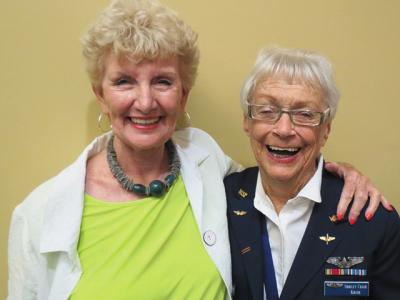‘Constant Hell’ for Brave Nurses of World War II

The book is called “We Band of Angels,” by Elizabeth Norman, and as Patricia DelGiorno begins to read aloud from it, she pauses, then apologizes when her voice catches.
The passage Ms. DelGiorno has chosen to share is about the Army and Navy nurses who persevered under heavy fire at a United States military hospital in Bataan, the Philippines, during World War II. She came upon the book during an extensive study of women who served as wartime nurses and pilots, codebreakers and spies. Even now, despite her acquaintance with the subject, Ms. DelGiorno said she remains amazed by their oft-forgotten bravery, their unwavering commitment, and their strength.
“These women volunteered to serve on the front lines, and they suffered through everything the men in World War II suffered,” said Ms. DelGiorno, who has woven her studies, historical photographs, and film clips into such presentations as “Nurses at the Front in World War II,” which she gave yesterday at the Rogers Memorial Library in Southampton in advance of Veterans Day on Sunday.
“On Dec. 8, 1941, the day after the attack on Pearl Harbor, the Japanese attacked the Philippines too, and these nurses and field hospitals were totally unprepared for that. The hospitals were overflowing. There were so many injured they had to put some of the men on the jungle floor, and that’s where they treated them. They eventually got word in Bataan that the peninsula was lost, and these nurses were ordered to leave for Corregidor,” she recounted during a phone interview.
“They were later captured by the Japanese and interned for the remainder of the war, into 1945. But when these nurses were interviewed about it later in life, it wasn’t their own fears that haunted them — it was having to leave these thousands of men on the floor of the jungle, bleeding, unarmed. They didn’t want to leave.”
For her Southampton presentation, Ms. DelGiorno wove the story of the Bataan nurses into a three-part talk that also included accounts of women who served at the Battle of the Bulge from December 1944 through January 1945, and at Anzio Beach in Italy, which came to be known as the “Half Acre of Hell” because the fighting there in ’44 was so fierce. In the film clips, some of the women speak about being prisoners of war and their postwar homecomings.
For Ms. DelGiorno, yesterday’s talk was the latest in a series of research efforts begun after she retired as a hospital executive and decided to pursue a master’s degree in English literature at Stony Brook University.
She has always been interested in women’s issues, she said, and was searching for a thesis topic when she happened to hear of a book about female agents in Special Operations Executive, created by Prime Minister Winston Churchill in 1940.
“Even though this particular book was a novel, it was based on real events, and so I bought the book and I was fascinated,” Ms. DelGiorno said. “Then I bought everything in the bibliography and read that, too. For my research, I went to England and visited the National Archives in the Imperial War Museum. Eventually, I did my thesis. But when it was over, I realized I kind of hated to leave these women.”
So she didn’t. Instead, during the summers of 2013 and 2014, she traveled from her Mattituck home to study more about women in World War II at Cambridge and Oxford Universities. In the years since, Ms. DelGiorno moved on to presentations about World War II-era female aviators, and also spoke with some real-life Rosie the Riveters, women who worked in factories when the men went off to war. She eventually became fascinated by tales of the 59,000 women who served in the Army and Navy as nurses — more than 30,000 of them as volunteers at the front — in part because World War II marked the first time women had served in combat so far behind enemy lines.
“At Anzio, these nurses were under three months of constant hell and bombardment and strafing, but they refused to leave their patients,” she said. “A number of them were killed. At one point they were trapped for three months. I have film clips of women who served there, and it really gives you a sense of what it was like. They faced starvation. Internment. P.T.S.D., though they didn’t call it that then.”
“At the Battle of the Bulge, it was the same situation. They worked in tent hospitals, and even though they had the red cross on the tops of the tents, the Germans strafed them anyway. They worked under horrific conditions, worked on the operating room table, as anesthetists, as bedside nurses. And again, they didn’t leave. They just showed such sacrifice and strength.”
Ms. DelGiorno’s talks have been very well received. She is frequently asked to speak at libraries and other venues on the East End, and has taught a six-week lifelong-learning class at Peconic Landing in Greenport.
“It’s been a labor of love,” she said.
Her next project may be a session with an Englishwoman who worked at Bletchley Park, the top-secret wartime site for British cryptanalysts that was depicted in the 2014 movie “The Imitation Game.”
“It’s become a passion of mine,”
she said.
